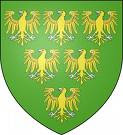January 1312 saw the birth of Piers Gaveston's and Margaret de Clare's only surviving child - a daughter named Joan. Joan was born at a perilous time for her father. He had been banished for the third time by the barons for his 'influence' over Edward II. As his wife was pregnant, it's likely Piers did not go far, and with the birth due in January, he was back in England - re-called once again by Edward II.
Margaret was born around the 12th or 13th of January. She was named Joan after the king's sister, Joan of Acre. Edward II collected his niece, Piers' wife Margaret, possibly from Wallingford castle, and took her to York to meet up with her husband. Of course, it seems Edward met up with Piers before Margaret did, which I'm sure Piers didn't object to! Typical of both of them! It may be Piers only ever intended to see his child born and spend time with his wife, before heading off back into exile, with plans for Margaret and his daughter to join him later. This all-changed. On January 18th, Edward II flouted the authority of the barons, and restored the Earldom of Cornwall to Piers. This set in motion a chain of events which would end in the killing of Piers on Blacklow Hill. On the death of her father, Joan was only 5 months old. Fortunately for Joan, Edward II became her guardian. This was due to Piers' lands being granted by the king, so Edward becoming her guardian was expected. It is hard to imagine that Edward would ever have abandoned the child of his beloved Piers anyway. Plus, her mother was his niece, so there was a blood relationship. No doubt Edward would have wanted to protect her and ensure she had a comfortable life and made a good marriage.
Joan was sent to live at Amesbury Priory in Wiltshire. The king's sister Mary was a nun there. Joan was placed in the custody of Eleanor de Bohun, another niece of Edward's. Joan was generously provided for.
Despite being the daughter of a perceived traitor, Joan was also a member of the king's family and had good marriage prospects. When she was barely 4 years old, Edward had the idea of marrying her to his ward Thomas, Lord Wake. Thomas was about 18 at the time. Such an age gap wasn't unusual for the times, and no doubt Edward was anxious to secure her future. Unfortunately for Thomas, he had married elsewhere without Edward's permission. Naturally, Edward was furious and imposed a heavy fine upon Thomas. Edward continued the search for a husband for Joan, and in 1317, his choice settled on John Multon. John was the son of Thomas Multon, lord of Egremont in Cumberland. John was nearer in age to Joan, being 9 in 1317. It was agreed the couple would marry at a suitable age, and there seems to have been plans for Joan to live with her bridegroom's family. Edward agreed to pay a dowry of £1,000. So anxious was Edward to provide Joan with a suitable marriage, that he extracted from Thomas Multon the promise of £10,000 should he fail to ensure the marriage took place. Joan's future had been secured. There's no doubt Edward expected his niece Margaret to re-marry. She was too young and valuable a widow not to. She would then more than likely bear her new husband children, hopefully a son, and would have little time for Joan. It was vital for Edward to ensure Joan was taken care of.
Sadly, all these plans came to nothing. Probably on her birthday, in 1325, Joan Gaveston died of an unknown illness. She would have been just 13 years old. We have no idea what the illness was. Nor do we know how Edward re-acted, though no doubt he mourned Piers' daughter. It was another break from Piers. We don't know how often Edward ever saw Joan. We have no records of her attending court, though she may have attended with her relatives at some point. We obviously don't know what she looked like, but I have to wonder, if she took after her father, and that if he ever did see her, how much she reminded Edward of her father. If only she had survived, married and had children, the direct legitimate descendants of Piers would be around today. I'm sure Piers would have been very proud.
Below is the Church of St Mary and St Melor in Amesbury, all that is left of the priory.
5 hours ago



